Spandau: Altstädter Ring
Axthelm Rolvien Architekten
Transformative Mobility and Quality of Life in the City
Our concept for the Altstädter Ring, the ring road bypassing Spandau's historic city centre, focuses on the transformation of mobility and creates an urban environment that simultaneously promotes ecological sustainability. As new mobility concepts fundamentally require the provision of appropriate spaces, our urban planning intervention envisages a new city park above the Altstädter Ring. In this way, new recreational and leisure areas can be combined with sustainable transport and logistics concepts.

Analysis of the problems
The Altstädter Ring, with its six lanes and four bus lanes in front of the town hall, is a hub for motorised private transport, buses, the U7 underground line and long-distance and regional rail services. The high traffic density leads to congestion, air pollution and noise. The car park along the ring road takes up too much sealed space. The networking of different modes of transport is inadequate. The connections for pedestrians are inadequate and the quality of stay is poor.
The street spaces are disproportionately large and the traffic areas are unstructured in terms of urban planning. The potential inner-city areas used for this purpose are considerable and could be better utilised for new residential quarters, for example. As a central transport hub, efficient planning of mobility concepts is necessary. The separation of the city districts caused by the traffic routes impairs pedestrian accessibility and the socially acceptable quality of life. At present, it is only possible to cross the road on foot at three points. The current situation comprises three lanes for private transport and one for buses in each direction, as well as a separate space for bus stops. This means a total road width of 35 metres.
High traffic density: One of the most serious problems is the combination of private, public and delivery traffic on the Altstädter Ring in combination with the railway. The road acts as a link between two important access roads to Berlin for more than 50,000 cars a day. This high traffic density not only leads to traffic jams and traffic obstructions, but also to environmental pollution due to air and noise pollution. The Altstädter Ring is an important mobility centre and it is therefore not possible to reduce the volume of traffic. Only a comprehensive restructuring of the area can be considered as a promising solution to the current urban development and traffic problems.
Excessive parking space: There are currently more than 110,000 square metres of sealed parking space with around 4,300 parking bays. This area takes up a considerable part of the urban space and needs to be reorganised. There is a need to find alternative solutions for parking space management that reduce the space required for stationary traffic and at the same time meet the needs of users when changing modes of transport.
Central transport hub: As a hub for 14 bus lines, the underground line U7 and the future extension of the underground line U2, as well as long-distance transport at Spandau station, the Altstädter Ring plays a crucial role in the public transport system. This central location offers opportunities for a more efficient and sustainable organisation of local public transport. As a hub and mobility hub, however, integrated planning of the urban space, optimised linking of the various modes of transport and restructuring of new construction potential are required.
Separation between neighbourhoods: The separation between neighbourhoods caused by the road structure of the Altstädter Ring contributes significantly to the fact that the social and economic integration of housing and commerce is hindered. The historic centre of Spandau is shielded from other parts of the city, which makes mobility and access to public facilities more difficult. A lack of transparency and missing pathways promotes social hotspots and excludes control mechanisms.
Lack of a station forecourt: One of the most serious deficiencies is the lack of an adequate station forecourt in front of Spandau station. A forecourt not only serves as an aesthetic welcome area for arriving travellers, but also provides an important function as a hub and distribution area for various modes of transport.
Lack of quality of stay: Another problem is the lack of quality of stay in the entire urban space. The bus stops offer hardly any seating for older people and people with limited mobility and are poorly protected against the weather. There is no recognisably safe way for pedestrians to cross the road. Well-placed and safe pedestrian crossings are not recognisable. Among other things, this reduces the acceptance of local public transport.
Unused green spaces in the parks: Parks are essential components of urban living spaces that are used for recreation, social interaction and encounters with nature. The green spaces around the Altstädter Ring are used little or not at all. These unused areas represent a missed opportunity to utilise the full potential of these valuable urban resources. Possible reasons for this include a lack of attractiveness, inadequate facilities and poor accessibility.
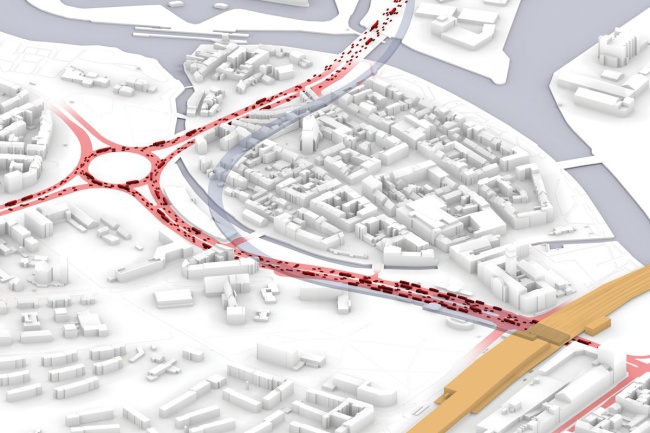
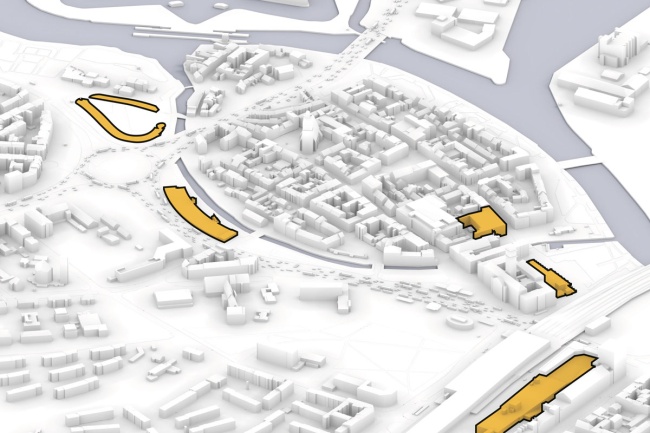
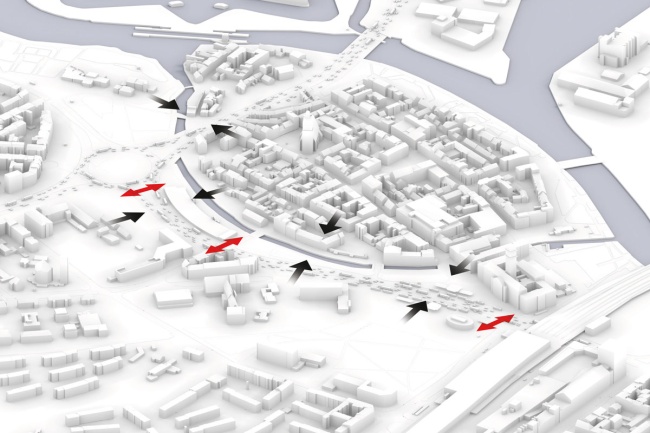
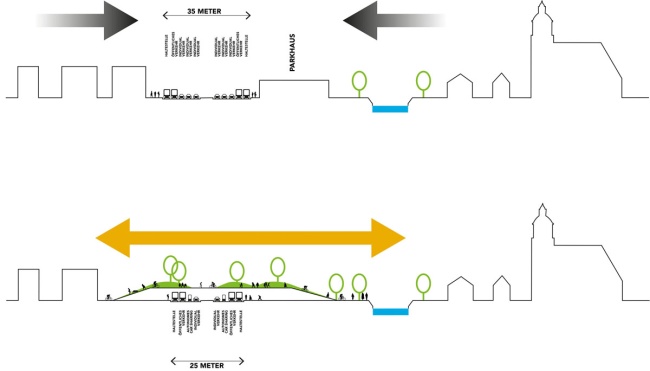
Solution approaches
The quality of life will be improved through traffic restructuring, the promotion of sustainable mobility and the construction of new neighbourhoods for around 700 flats and commercial developments.
The restructuring and partial overbuilding of traffic and recreational areas will allow all parts of the city to be reached on foot in future while maintaining the necessary transport infrastructure.
A new city park as a topographical, park-like link aims to create a more liveable, sustainable city while retaining the necessary space potential for future-oriented mobility concepts and separating the highly frequented traffic routes from the recreational areas within walking distance.
Mobility HUBs and micromobility are the central elements of an innovative transport concept. The networking of sustainable means of transport such as self-driving private transport, digitalised car sharing, autonomous delivery drones, urban air mobility, e-scooters, bike sharing, cargo bikes, etc. promotes inner-city mobility and reduces environmental pollution such as noise and CO2 emissions.
In future, only one lane will be provided for individual traffic, one lane for autonomous traffic and another for public transport. However, traffic calming by reducing the number of lanes is not enough to overcome the many urban planning and infrastructural problems. Exclusively traffic-calming measures will only shift traffic to the neighbouring streets and the associated problems.
An elevated city park can create a sustainable green urban space by building over the traffic routes, taking into account optimised lighting and ventilation conditions, and thus optimise the previously inadequate infrastructure of too narrow footpaths, lack of cycle paths and poor quality of stay. The functional structuring of traffic and recreational areas improves safety and comfort for non-motorised road users and enables the development of attractive urban spaces with optimised pathways and functional offerings. The Altstädter Ring in Spandau is developing into an attractive urban neighbourhood with innovative traffic and residential concepts.

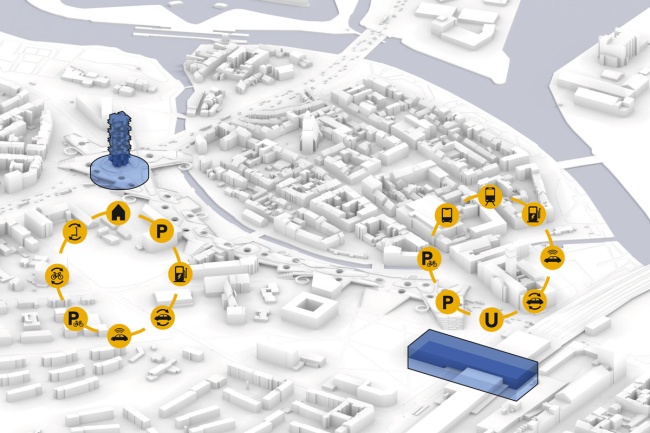
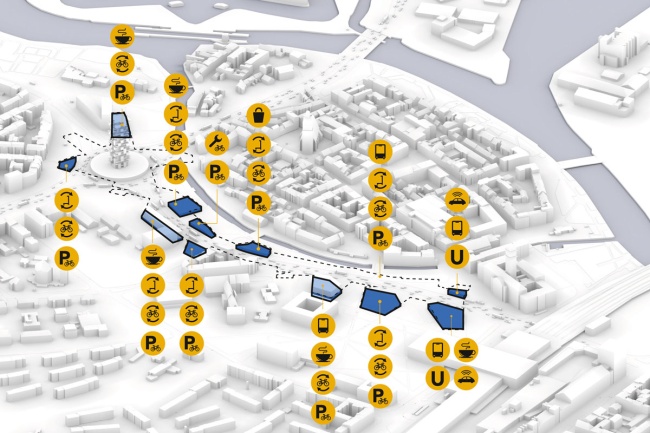
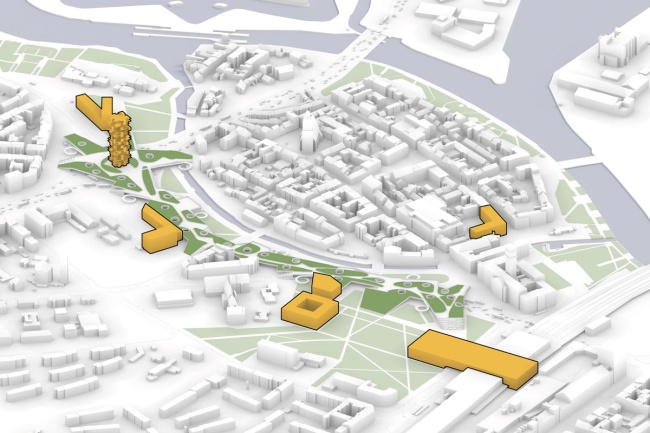
Restructuring of existing green spaces: The existing green spaces are to be redesigned and actively utilised in order to increase the quality of life for residents and promote urban biodiversity. The integration of parks and green spaces into the urban structure will create attractive recreational areas that invite people to relax and unwind.
Elevated city park above the Altstädter Ring road: These new green spaces are intended to play an important role as a green lung in improving the urban microclimate and serve as a striking landscape element. Furthermore, the elevated city park provides a connection for pedestrians, bicycles, etc. between the historic old town and the neighbouring city districts, thus creating a sense of continuity and urban cohesion. The restructuring of new building areas can be used to develop new commercial spaces and residential neighbourhoods that complement urban life. The example of the Porta Garibaldi railway station in Milan with the Parco Biblioteca degli Alberi in conjunction with the Bosco Verticale development is an impressive example of how urban architecture and urban green spaces can be realised in a future-oriented and sustainable way.
Green wall around the car-free old town: A border in the form of green spaces will help to enhance the areas along the historic old town and the riverside promenade. The old town is to be largely car-free and delivery traffic is to be restructured to reduce the impact of car traffic.
Restructuring of lanes and intermodal transport systems: By rearranging the lanes of the Old Town ring road and promoting autonomous car sharing systems, we hope to reduce individually used transport and encourage more efficient, or sustainable, forms of mobility. This can be achieved by creating exclusive lanes for digitally and autonomously controlled cars, by improving the infrastructure for bicycles, scooters and other small vehicles, as well as by promoting and making public transport more accessible.
E-mobility and autonomous driving: In addition, innovative transport concepts and digitalisation technologies should be used to make transport more efficient and better link the individual modes of transport. The transition to e-mobility and autonomous driving is changing the way we look at the design of urban infrastructures. Promoting e-mobility with large-scale photovoltaic systems on railway station premises could also help to reduce CO2 emissions. We want to ensure that the technological potential already available contributes to improving the efficiency and sustainability of our city.
Loading capacity and digitalisation of parking spaces: The digitalisation of parking spaces can make it easier to find a parking space and optimise the use of existing parking space, as well as facilitate the efficient management of urban mobility. The implementation of intelligent car park management systems reduces congestion and improves the user experience. The integration of electric cars as an energy storage volume in urban energy management makes more efficient use of renewable energy and stabilises the electricity grid.
Optimised mobility concept: The optimised mobility concept through Mobility Hub and Micro Mobility ensures an efficient and sustainable transport infrastructure through convenience, safety and high frequency to meet the needs of users. Areas for autonomous car sharing, scooter sharing, bike sharing, a bicycle service station and bicycle parking spaces will be created on the lower level of the city park. The integrative approach of linking the various modes of transport with each other, as well as sustainability through electromobility and renewable energies, contribute to the attractiveness and efficiency of the mobility solution.
A new train station with station forecourt as an intermodal centre: An extension or conversion of the train station, which will be designed as an intermodal centre or mobility hub in the future, will create a connection to the city, provide parking spaces and areas for autonomous car-sharing vehicles and make it easier to switch to other means of public transport. The creation of a spacious, well-designed forecourt can not only improve functionality, but also significantly increase the quality of stay. This square could serve as a meeting point and distribution area to better direct different traffic flows.
Iconic building on Falkenseer Platz: To revitalise the roundabout and make efficient use of the 6,000 m² area, we propose the creation of an iconic building that serves as a landmark. This multifunctional building will house offices, car parks and complementary services and will also serve as another part of the mobility hub. A drone airfield on the roof for delivery traffic and passenger transport can revolutionise the future of urban mobility and logistics. With a pioneering utilisation concept, this building can be an important part of smarter and more sustainable mobility on the Altstädter Ring.
Creating new living space: Another important aspect of the urban redevelopment is the creation of new living space. Around 150,000 square metres of new gross floor space can be created around the Altstädter Ring with the help of area transformation and new construction. The aim is to increase the attractiveness of the location as a residential neighbourhood in order to achieve a sustainable revitalisation of the entire district. Innovative construction methods, new residential concepts and sustainable urban planning can create attractive and affordable living space on a large scale.
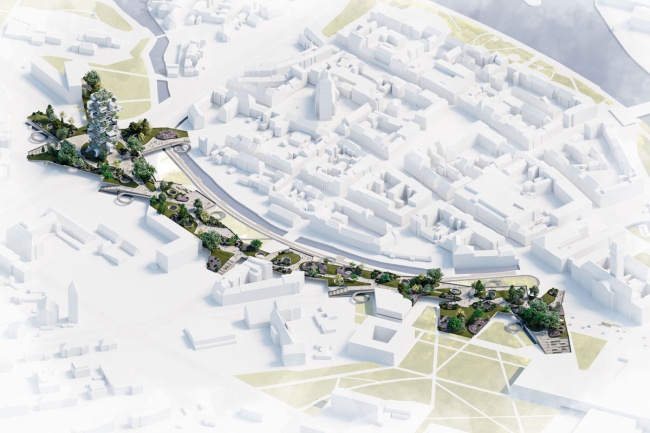
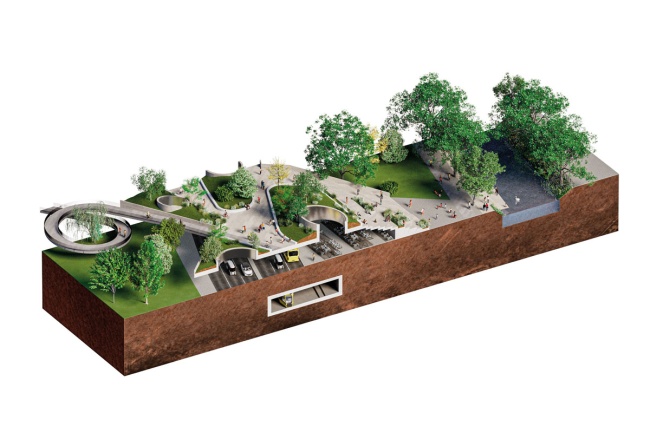
Conclusion
To summarise, the proposed interventions for the Old Town Ring represent a decisive step towards a more liveable, sustainable and fully integrated city. By overcoming the challenges of an indispensable volume of traffic, the multi-layered transfer needs, a comfortably functioning local and long-distance transport system and the basic urban planning requirements necessary for this, we can use innovative solutions to transform the necessary traffic space with all its mobility requirements into an urban space that takes account of urban life in all its facets. By comprehensively restructuring the green spaces, relieving traffic congestion and promoting sustainable mobility, as well as creating new housing and commercial space, a more liveable and sustainable city can emerge in place of the previously heavily congested transport hub.

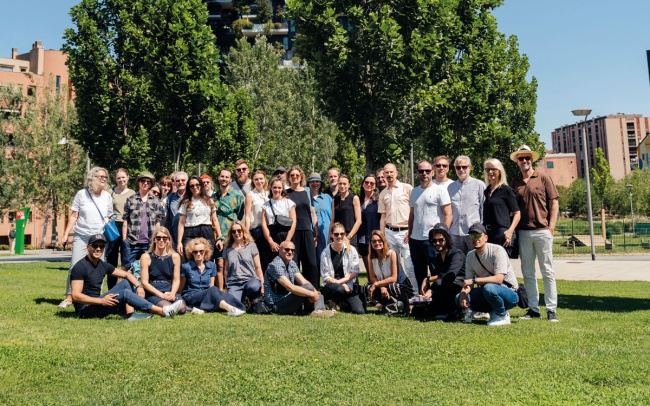
The team
Axthelm Rolvien Architects specialises in anticipatory design, responding to questions posed by future demands on urban development and building. “Straightforward consistency, informed by functional necessity, defines our architecture. The designs are noted for a high standard of sustainability, material and significance.”
https://www.axthelm-rolvien.de/